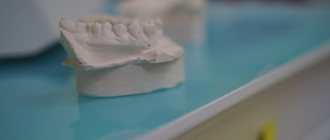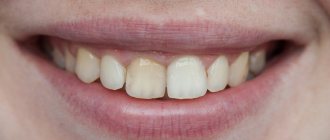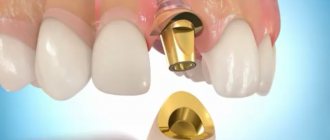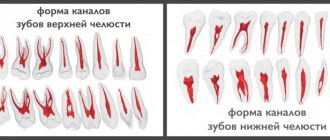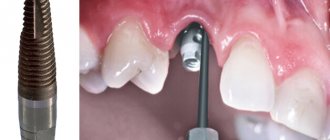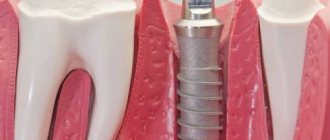Dental implants are artificial analogues of tooth roots. They are used to restore lost teeth and serve as support for crowns or dentures. Installation of structures into the jawbone is traumatic, which requires long-term rehabilitation. Sometimes, for various reasons, pain may occur under the implant. If in the first days after surgery they are normal, then in the long term they may indicate the development of complications. To eliminate the problem, it is important to determine its cause, as well as analyze the accompanying symptoms.
Is aching pain after implant placement normal?
Implant surgery may be accompanied by temporary side effects:
- pain in the tooth and gum area;
- swelling of the gums, their bleeding;
- slight increase in body temperature;
- the presence of small hematomas.
Such symptoms are called early complications that accompany each surgical intervention. They are considered standard consequences that arise from a successful outcome of the operation and do not pose a threat to health. Correct installation of the prosthesis may be accompanied by aching pain in the gum and tooth area. This is due to the process of implantation of a foreign object into the tissue. The pain goes away after 3-4 days. It is during this period that the implant is accepted by living tissue.
If the operation is performed incorrectly, the implant may be rejected, the early signs of which are incessant pain in the gums, adjacent teeth, and a sharp increase in temperature.
Implant rejection: should you be afraid?
In very rare cases, implant failure occurs, requiring surgical intervention. The following symptoms indicate this problem:
- acute pain;
- strong bad breath;
- mobility of the structure;
- redness and swelling of the mucous membrane near the implant plug.
We will look at the symptoms of complications in more detail below. Again, implant failure is extremely rare. According to statistics, new teeth do not take root in only 3-5% of cases. For example, German or Swiss implants will take root in 98% of procedures, and Russian or Israeli implants in 95%.
Therefore, if you detect even all of the listed symptoms, you should not set yourself up for negativity. Most likely, inflammation of the gums after installation of an implant is caused by more harmless reasons. Which ones? Let's deal with all the questions in order.
When should the pain go away?
Pain during the rehabilitation period is present after any surgical intervention. Implantation is no exception. Aching pain in the gums appears after the anesthesia wears off and can last for several days. It is important to monitor the intensity of pain and well-being. Normally, pain should not persist for more than three days. The duration of pain depends on the physiological characteristics of the body.
The doctor will give recommendations regarding treatment during the rehabilitation period. Ignoring therapy can significantly prolong recovery time.
Pain during implantation, is it painful to install an implant?
For those who were once familiar with the removal of eights (wisdom teeth), they know how unpleasant it is. Implantation is a completely painless operation. The anesthesia is enough to make everything comfortable. The patient feels manipulation in the oral cavity, but there is no pain. Even the injection itself with an anesthetic solution can be made invisible. After treating the puncture site with special means.
There are several types of anesthesia for implantation:
- local
, used in most cases.
It is quite enough for work. An injection is given and within a few minutes the medicine begins to act. Installation of one implant takes 15-30 minutes
, and the effect of anesthesia ends after a few hours; - sedation
_ The patient is half asleep, there are no unpleasant sensations, but there may be consequences; - anesthesia
_ To undergo implantation under anesthesia, you will need to undergo certain tests and consult an anesthesiologist. Coming out of anesthesia takes time. This method is used very rarely, it is not available in all clinics and can be dangerous.
Why complications may occur
To minimize the risk of complications, the doctor must make sure that implantation is not contraindicated and the patient’s body can bear the load. There are relative and absolute contraindications.
Relative contraindications are:
- pregnancy, lactation;
- treatment with hormones, chemotherapy;
- age over 60 years;
- bad habits;
- type 2 diabetes mellitus;
- jaw injuries;
- cariogenic situation in the oral cavity;
- chronic diseases.
Installation of implants in these cases may have a long recovery period. The pain may persist for several weeks.
Difficult implantation is also observed in the case of:
- non-compliance with installation technology;
- lack of proper oral care in the postoperative period;
- refusal of therapy during rehabilitation.
Implantation is not possible if:
- HIV infections;
- chronic diseases of bone and connective tissue;
- blood diseases;
- oncology;
- diseases of the lungs, kidneys, liver;
- endocrine diseases.
The absence of contraindications does not guarantee the absence of complications. The qualifications of the doctor play a huge role. A competent specialist will promptly eliminate any complications that arise and prevent their development.
Prevention of peri-implantitis development
Thus, the following solutions allow us to solve the problem of the development of peri-implantitis:
- thorough diagnosis of the patient’s condition and planning of the treatment process,
- the choice of solid implants in which the intraosseous part is connected to the abutment, especially in situations where tooth restoration is carried out in the presence of generalized periodontitis,
- the choice of two-piece implants with an antimicrobial coating at the upper base of the implant body, as well as the use of abutments with a smooth antimicrobial coating,
- the use of polished implants that will not accumulate plaque,
- the use of implant models that transfer less load to the alveolar bone, which is susceptible to inflammatory processes,
- strict adherence by the patient to all recommendations of his doctor.
Thus, the main recommendation for patients is to choose a professional doctor who follows modern trends in the field of implantology, improves his skills, works with high-quality brands of implants and uses safe implantation protocols.
More examples 1 According to clinical studies of implant manufacturing companies: Nobel, Straumann, Astra Tech. 2 According to studies published in the journal Perio-implant advisory. 3 Esposito M1, Grusovin MG, Worthington HV Treatment of peri-implantitis: what interventions are effective? A Cochrane systematic review.
What can cause pain during the healing process?
The engraftment process is purely individual. Complications during the engraftment process are caused by:
- Decreased immunity.
- Exacerbation of chronic diseases.
- Infections.
- Injury to the maxillofacial apparatus.
- Failure to comply with the surgical protocol.
- Overheating of the bone during implantation.
- Formation of a blood clot between the implant and the gum.
- Insufficient hygiene.
Poor hygiene promotes the development of bacteria that penetrate under the gums and cause inflammation. Next, the infection descends into the deep layers of tissue surrounding the implant, where it causes inflammation of the bone structure.
Causes of pain
During dental implantation, a foreign body is introduced into the alveolar ridge, which inevitably damages the gums, blood vessels, and bone tissue.
The body needs time to recover and adapt to the installed structure. At this time, inflammation develops in damaged tissues, which triggers the regeneration process.
Mechanical injury and fluid accumulation lead to irritation of nerve endings, which a person feels in the form of pain.
After suppressing the inflammation, the swelling goes away, the tissues are restored, and the discomfort gradually disappears.
What to do if there is aching or sharp pain and swelling
Dull aching pain for a short time in the postoperative period is normal. To alleviate it and prevent the development of acute pain, you need to follow the following recommendations:
- Apply cold compresses. A cold pack is applied to the side where the operation was performed at intervals of 20 minutes. A break is necessary to prevent hypothermia. Cold application can be carried out within one and a half days after surgery.
- Wipe soft tissues with a special solution. You need to make it yourself from: 1 tsp. salt, five drops of iodine, 200 ml of water.
- You can take a painkiller 2 hours after surgery. The permissible interval between doses of analgesics is 4 hours.
- Maintain oral hygiene to avoid infection. When brushing your teeth, do not touch the implantation site with a brush, but wipe with a cotton swab and saline solution.
- Temporarily avoid solid, hot, spicy foods.
Acute pain indicates inflammation and requires urgent medical attention.
Pharmacy medicines
To relieve swelling from soft tissues, the following is prescribed:
- Chlorhexidine bigluconate 0.5% . Rinse the mouth with the solution up to six times a day for several days.
- Betadine 10 % Use 6 drops of solution for external use per glass of water. Rinsing is carried out according to the scheme of the first drug.
- Solcoseryl . Dental paste is applied to the wound after rinsing. It provides wound protection, pain relief, and promotes healing. The paste can be used by expectant mothers.
- Antibiotics . Amoxiclav, Flemoklav, Augmentin have an antimicrobial effect and stop the spread of infection. Prescribe one tablet twice a day for five days.
- Nonsteroidal anti-inflammatory drugs . Nimesulide, Analgin, Voltaren, Ketanov are taken if the implantation site and the areas around it hurt.
Drugs that relieve pain and reduce fever do not require systematic administration.
Folk recipes
The following medications can help minimize pain and relieve swelling:
- Kefir . Rinsing with kefir is repeated every three hours for a week.
- Sea buckthorn oil and vitamin A. The drugs are applied to the gums and promote wound healing.
- Chamomile infusion . The collection is brewed, allowed to brew and rinsed in the mouth. A glass of boiling water requires 1 teaspoon of the plant. You can brew chamomile and calendula flowers in equal proportions. This mixture is boiled for 15 minutes.
- Propolis-based ointment . The drug is applied to the gums and left. It disinfects well and relieves inflammation.
- Decoction of echinacea and eucalyptus . Rinse every 5 hours. Take a tablespoon of the mixture per glass of water. The mixture is boiled for 15-20 minutes.
- Fish oil, flaxseed oil . Products containing Omega 3 fatty acids help restore gums.
- Aloe leaf pulp . A fresh leaf is crushed, wrapped in a bandage and applied to the gum.
- Plantain . Used as a compress from crushed leaves, as a decoction for rinsing. The dry plant is poured with water, boiled for 15-20 minutes, cooled and rinsed.
- Calendula . Rinse the mouth with an infused decoction of calendula 3 times a day.
How long does it take to insert a tooth?
The duration of the tooth restoration procedure depends on the restoration method. If the tooth is destroyed by no more than 1/3 and has a intact root, it can be restored directly in the patient’s mouth in one visit. If the root is preserved and the crown part of the tooth is destroyed by more than 1/3, you can resort to microprosthetics, which is also performed in one visit.
If the coronal part is significantly destroyed and the tooth must be removed, implantation or installation of a bridge structure supported by adjacent teeth is indicated. If the patient chooses implantation, then modern protocols make it possible to restore the integrity of the jaw row in one or two visits. The traditional protocol involves allowing the implant to heal for about six months and, if osseointegration is successful, installing a permanent crown.
When to be wary if your gums ache after dental implantation
During the healing period
Standard complications after dental implantation are quite common. In most cases, following medical recommendations is enough to heal the wound and normalize the condition. Aching pain after implantation should cause concern if there are accompanying symptoms:
- swelling of the gums at the implantation site and nearby;
- sore gums;
- discharge of pus;
- bleeding;
- enlargement of the gum pocket;
- mobility of the structure;
- elevated body temperature.
If these symptoms are present, an emergency visit to a doctor is required. Because there is a high risk:
- seam divergence;
- inflammation of the maxillary sinuses;
- peri-implantitis;
- damage or rejection of the implant.
During operation
The patient who has implants installed must understand that the service life of the artificial root depends on compliance with medical recommendations and a responsible attitude towards one’s own health. If there are no complaints, a dental consultation is recommended once a year. If the following symptoms appear, you should immediately visit a doctor:
- resumption of pain of any intensity;
- discomfort;
- swelling of the gums;
- their redness;
- bleeding of the mucous membranes of the oral cavity;
- the appearance of itching.
The listed symptoms may indicate the development of gingivitis or stomatitis, which can provoke the appearance of peri-implantitis, and if left untreated, rejection of the structure.
Treatment of peri-implantitis with preservation of the implant is effective only in the early stages of the disease. In case of recurrence of the disease, as well as when applying at later stages, removal of the structure followed by reimplantation is required.
- Complete restoration of the dentition in just 4 days!
more detailsRoott Pterygoid Implants Sinus lift is no longer needed!
more details
Once and for life! Express implantation in 4 days with a permanent ReSmile prosthesis
more details
All-on-4, All-on-6, ReSmile, Zygomatic implantation We use all modern methods of dentition restoration
more details
How long do implants take to take root?
On average, implants take root in the lower jaw in 2-4 months, and in the upper jaw in 5-6. The bones of the lower jaw are generally larger, stronger and better supplied with blood, but above the upper jaw there is a maxillary sinus, which often brings additional difficulties when installing an implant.
In the language of science, the process of fusion of metal roots with bone is called osseointegration. Engraftment begins immediately after installation of the implant. The healing time of the gums and bones depends on the health of the patient, the condition of the jaw and the quality of the model itself.
The process of bone and implant fusion is influenced by many factors, of which the following can be distinguished:
- presence of allergies to implant components;
- deviation from doctor's recommendations;
- doctors' mistakes;
- bad habits (smoking);
- low quality implants.
According to statistics, inflammation of the gums near the implant and rejection of a foreign body are observed in most cases in the first days after the installation of new “roots”. The patient immediately feels that there are complications after the operation, and he needs to urgently consult a doctor.
However, even if inflammation of the gums near the implant does not occur, and the structure has taken root safely, the patient should be vigilant. In very rare cases, the implant may fail several months or several years after its installation.
Normal sensations after implantation
Due to inevitable tissue trauma after implantation, the following symptoms are considered normal:
- swelling of the gums (in rare cases, the entire cheek swells);
- redness of the gums;
- discomfort and pain in the jaw at the site of the installed implant.
If the healing process goes well, after 3-7 days all unpleasant manifestations will go away. If the patient experiences pain, swelling increases day by day and healing does not occur, be sure to go to the dentist as soon as possible.
Signs of inflammation
Peri-implantitis, or inflammation of the tissue adjacent to the implant, can affect both soft and bone tissue. The gums become weaker, the bones are gradually destroyed, the implant begins to loosen and is rejected.
The first symptoms of peri-implantitis are similar to the usual consequences of surgery. However, the onset of rejection is more pronounced. Peri-implantitis is characterized by:
- acute pain that does not go away within 1-2 weeks after implantation;
- redness and swelling of the gums, which persist for more than 3-4 days;
- Blood flows from the wound for a long time (exudate). The ichor does not stop for more than 7 days;
- implant mobility;
- unpleasant odor under the plugs on the implants;
- discharge of pus from the gums, appearance of ulcers near the implants;
- increase in body temperature.
All of the above signs may be evidence of implant rejection and require urgent consultation with a dentist. If you notice at least one such alarming symptom, consult a doctor as soon as possible.
Why do implants fail?
The most common cause of implant failure is medical errors:
- incorrectly selected size and design of the implant, due to which it cannot attach to the bone;
- non-sterile working instrument;
- overheating of tissues when drilling holes for the implant;
- incomplete information about the patient’s health status.
Often the cause of implant rejection and gum inflammation is the lack of sufficient bone tissue to secure it (bone atrophy). This problem can be solved with basal bone implantation, which ensures maximum fusion.
Another common reason for implant failure is the patient’s incorrect actions during the rehabilitation period. Even if the doctor performed the installation operation perfectly, in the following days it is important to treat yourself carefully and follow all the specialist’s recommendations.
During the engraftment period it is prohibited:
- load the implant;
- overheat/overcool;
- hide health problems and body characteristics from the doctor;
Even if it seems to you that your health problems are insignificant, and the characteristics of your body have nothing to do with the implantation procedure, tell your doctor about all possible ailments. Often, what seems frivolous to you can fundamentally affect the treatment method.
If the implants do not fail in the first two years after installation, we can assume that the operation was successful. However, the problem of rejection can overtake the patient several years after the operation. As a rule, such a situation occurs against the background of exacerbation of chronic diseases or mechanical injuries. Diabetes, tuberculosis, AIDS and cardiovascular diseases can lead to implant failure.
What to do if inflammation begins after a few years?
If, after 2,3 or even 5 years of a quiet life with an implant, you notice that the gums under the crown or next to it have begun to swell, bleed, and you have begun to suffer from bad breath, immediately contact your dentist. The doctor will conduct a comprehensive examination of the oral cavity, order an x-ray and, if necessary, open the wound to clean out the pus.
Unfortunately, even after a few years, if there are signs of re-implantitis, and therefore a serious threat to the life and health of the patient, the doctor will order removal of the implant.
Is re-implantation possible?
In most cases, 2-3 months after removal of the implant, a new structure can be installed. After removal of the previous implant, no more than 1-2 months should pass, otherwise the bone tissue may atrophy due to the significant load.
Is it possible to protect yourself from gum inflammation?
Of course you can. The main thing is to be attentive to yourself and take care of the health of your teeth and gums after installing an implant.
Here are some useful recommendations, following which you can avoid most problems both immediately after surgery and several years after implantation:
- Be aware of your responsibility
. Remember, your health is in your hands. Even if the implantologist performed the operation perfectly, and the selected designs suited your body perfectly, an irresponsible attitude and the patient’s failure to comply with the doctor’s instructions can lead to serious health problems. - Visit your dentist regularly.
Not only in the first weeks and months after implantation you need to go to the doctor. To avoid inflammation of the gums and rejection of foreign bodies, the patient must visit the dentist once every six months. - Give up bad habits.
Just imagine: dental implants in smokers are rejected 30% more often than in healthy people without bad habits. Nicotine and toxic tars after a fairly short time lead to disruption of mucosal nutrition and rejection of implants. - Take care of your new teeth and gums.
Understand that implants and crowns are more fragile natural teeth that need to be cared for. Follow your doctor's instructions, and after implantation, regularly take medications prescribed by a specialist to speed up the healing process of your gums. Take care of your new teeth: brush them morning and evening, remove food debris after eating. Therapeutic and prophylactic effect will be provided by ASEPTA ACTIVE toothpaste. The product is intended for gentle cleansing of the oral cavity, and also guarantees comprehensive protection of teeth and gums from pathogenic bacteria. - , visit your dentist
as soon as possible . Remember, to avoid inflammation of the gums around the implant, you should take care not only of the new teeth, but also of the gums.
Now you know how to reduce the risk of inflammation after implant installation to zero. We are sure that your new teeth will definitely take root and serve you faithfully for many decades.
Average cost in Moscow
Cost of medications for home treatment
| Name of service | Cost, rub. |
| Ointments and gels | |
| Chlorhexidine | 16 |
| Betadine solution 10% 120 ml | 280 |
| Solcoseryl | 370 |
| Folk remedies | |
| Chamomile flowers | 60 |
| Harvesting plantain | 70 |
| Calendula flowers | 110 |
| Fish fat | 140 |
| Sea buckthorn oil | 220 |
| Propolis tincture | 300 |
| Anti-inflammatory and painkillers | |
| Analgin | 50 |
| Voltaren | 230 |
| Amoxiclav | 310 |
| Nimesil | 700 |
Cost of treatment of complications in dentistry
| Name of service | Cost, rub. |
| Specialist consultations | |
| Dentist | 600 |
| Periodontologist | 740 |
| Implantologist | 820 |
| Treatment | |
| Removing dental plaque in the area of one tooth | 180 |
| Periodontal applications in the area of one tooth | 370 |
| Application of a protective periodontal bandage | 400 |
| Laser therapy of the gum mucosa | 490 |
| Implant removal | 6900 |
| Implantation of osteoconductive material in the area of one tooth | 10900 |
| Implantation of a protective membrane | 12900 |
Prevention of negative consequences
The development of complications after dental implantation can be prevented. To do this, the doctor must perform the operation strictly according to the protocol and observe sterile conditions. The patient is responsible for postoperative care and following the specialist’s recommendations.
Among them:
- mandatory smoking cessation;
- taking prescribed medications;
- applying cold to the cheek in the first hours after implantation;
- regular rinsing of the mouth with antiseptic solutions;
- maintaining hygiene (daily brushing of teeth);
- exclusion from the diet of solid foods, spicy, sour, hot, cold foods, strong coffee;
- refusal to visit the sauna, bathhouse.
It is recommended to limit any physical activity and avoid crowded places. This will help prevent infection with a viral infection, which is undesirable during the period of osseointegration.
Indications for implant removal
- Rejection of the structure mainly develops within six months after implantation.
- Peri-implantitis or perimucositis - the first is accompanied by a loss of jaw bone against the background of inflammation of the soft tissues, the second occurs without loss of tissue volume.
- Excessive load on the implant - occurs due to violation of the installation protocol.
- Incorrect position or defective implant is extremely rare.
- End of service life - for models with limited serviceability.
In our clinic, implant installation is carried out strictly in accordance with surgical protocols, using the most reliable systems in the world, Nobel Biocare (USA), with a lifetime warranty from the manufacturer and almost zero risk of rejection. If an unpleasant situation does arise, we guarantee free dismantling of the structure.
